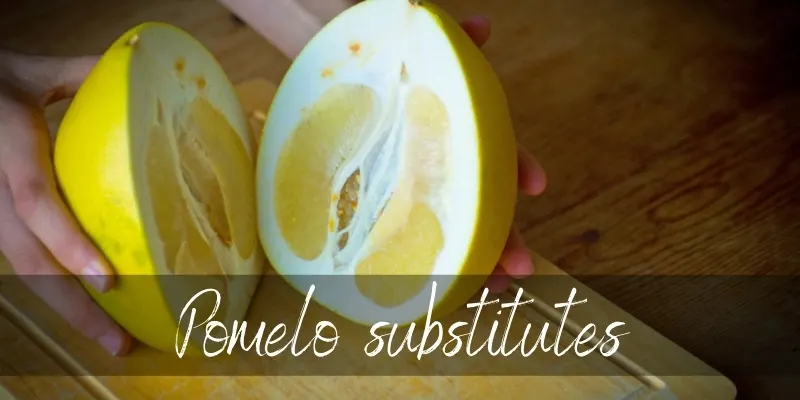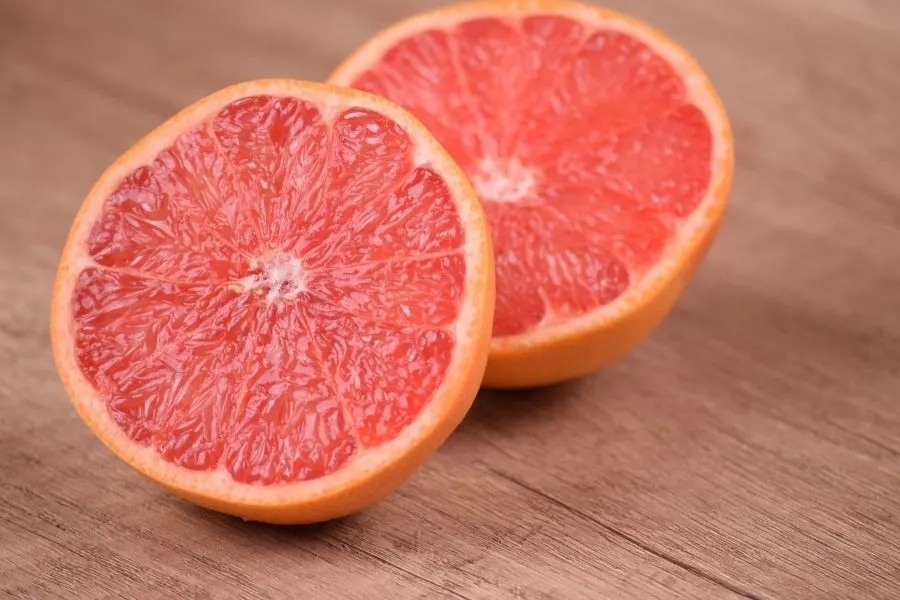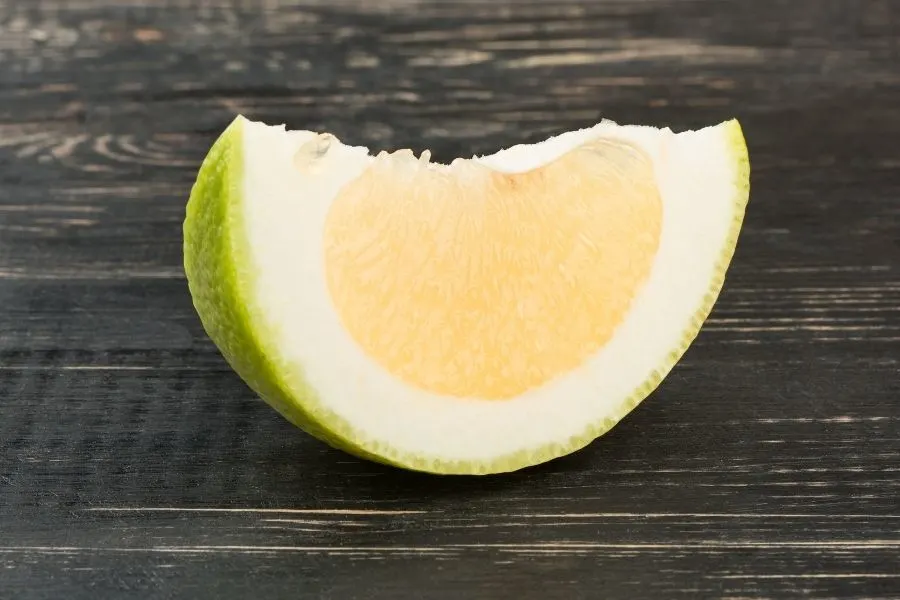Pomelo (Citrus Grandis), also known as a shaddock, pompelmo, and pummelo, is a very juicy and sweet giant citrus. Pomelo is the perfect choice for salads and fruit dishes. It’s colored in light-yellow to coral-pink, thick-skinned, but soft and easy to peel away, with a sweet-tart flavor. You can’t help but love it!
But, if it’s not always at your fingertips, and you crave its succulent relish, you will undoubtedly seek for pomelo substitute. To ease your demand, we have made a list of fruits that can replace this extraordinary citrus, at least for a day.

Best pomelo substitute
Some of the best pomelo substitutes are sweet grapefruit, melogold, oroblanco, and lavender gem. Your best chance to find any of these is in Asian-themed markets, no matter where you are.
Although nothing can replace its mouth-watering and unique taste, let’s see which fruit is closest to pomelo:
Sweet Grapefruit
While much juicier than pomelo, sweet grapefruit is the best pomelo substitute you can easily find on the market. Interestingly, even the honeyed variety of this fruit is more bitter than pomelo. Even though the sweet grapefruit’s taste is a decent pomelo substitute, the texture is softer, and there is also more liquid. Accordingly, it’s important to adapt your recipes to enjoy this replacement to the maximum.

Melogold
Melogold is also an excellent cover for pomelo. Like a pomelo, this amazing fruit has a thicker rind. It’s almost seedless and very succulent. Melogold is a great choice for salads and fruit cocktails. Although the outstanding hybrid, it’s only available for a few short months. Since it’s not the commonly citrus variety, it’s more challenging to find it on the market during the year.
Oroblanco
Oroblanco, known as white gold, is a citrus hybrid between a white grapefruit and an acid-less pomelo. With thick skin like pomelo and taste like grapefruit, Oroblanco is seedless like a Melogold. This exciting hybrid is also a great alternative to pomelo. People who already tried this fantastic fruit say that it’s like a grapefruit with the sugar already added. But, no worries, it has low-calorie content so that you can enjoy this pomelo substitute without remorse!

Lavender Gem
A hybrid of a tangerine and a grapefruit, Levander Gem is probably the most interesting pomelo substitute. It looks like a small grapefruit, but its sweet taste reminds you of pomelo. It’s slightly acidic but full of juice, making it the right for juicing, refreshing beverages, and marinades.
Read also: Pomelo Varieties
Pomelo history
Coming from Malaysia and Indonesia, where it grows widely and abundantly, even nowadays, pomelo can reach up to an impressive 25 pounds and a foot in diameter. So, it’s not surprising that this is the largest of all citrus in the world. But don’t let this gigantic look fool you. This fruit is so succulent that you won’t be able to resist it!
Interestingly, it’s presumed that the Chinese people have been cultivated pomelo for thousands of years. It was an indispensable part of their rituals. To be specific, they used to boil the pomelo’s skins and the leaves to prepare a ceremonial bath to cleanse a person and repel evil.
Pomelo is also cultivated in Israel and California. Most of its varieties found today have been grown and bred.
Don’t mix pomelo with the following fruits
Grapefruit
Pomelo looks like a more massive grapefruit, and people often mix these two species. They are both citrus fruits, but all the similarities end here – the confusion dated back to the distant past when the names were used interchangeably. And there is another, a less-known fact which draws the line between these two fruits. Believe it or not, pomelo is responsible for the existence of grapefruit! Pomelo has been crossed with sweet orange to produce grapefruit! The outcome is that the grapefruit is a hybrid, while pomelo is a separate species.
These two fruits differ in almost every way, from shape and color to size and taste. While pomelo is the largest of all citrus fruits and can grow to be the watermelon’s size, grapefruit is significantly smaller. Pomelo also has a thicker rind than the grapefruit. On the contrary, they both have a sweet-sour flavor with a bitter note and are rich in vitamin C, antioxidants, and fiber. Despite their commonalities, these two citrus fruits aren’t interchangeable.
Mandelo
Mandelo, also known as a cocktail grapefruit, is another pomelo hybrid, but much more like mandarin or tangerine in flavor and texture. Despite their name, “cocktail grapefruits,” they are not grapefruits. With their slightly sour and sweet taste, they reminiscent of pomelos and are extremely easy to peel and juice. But unlike a pomelo, the cocktail grapefruit’s membranes are relatively thin. Mandelo is entirely edible and usable, from skin and flesh to seeds.
The name Mandelo comes from a combination of two words – mandarin and pomelo, but the cocktail grapefruit name is much more in use nowadays, especially among distributors and growers.
Read Also: Pomelo VS Yuzu
Pomelo types
There are a few variations of pomelo, so let’s take a more in-depth look at the diverse pomelo types:
- Honey Pomelo. One of the best-known sub-species of pomelo is the honey pomelo from China. It’s also enormous, moderately succulent, and, as the name implies, sweeter than typical pomelo. It has white flesh, and depending on the species, has little to no seeds.
- Siamese Sweet. This pomelo variation also has a sweet but a bit bitter flavor. Siamese Sweet is a vital citrus parent crossed with many other fruits to produce various exciting commercial fruits. Thanks to its juicy taste, it is the ideal solution for salads.
- Chandler. Like a Siamese Sweet, Chandler also has a sweet but slightly bitter flavor. This famous, pink-fleshed cultivar is a hybrid made due to a Siamese Sweet and a Siamese Pink. The texture is juicier than their parent fruits, and the flavor is sweeter.
There are many pomelo substitutes, and which one you will choose depends only on your taste, lifestyle, and their availabilities on the market, as well as on your favorite recipes!

